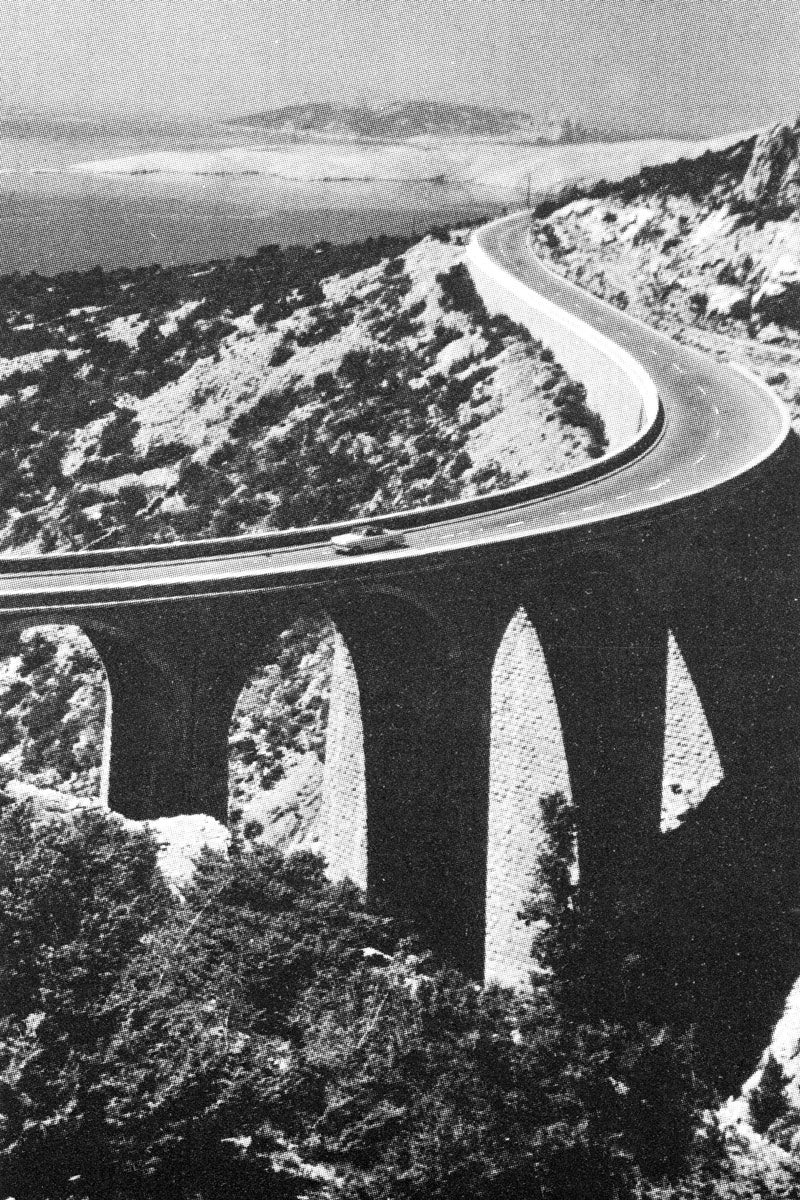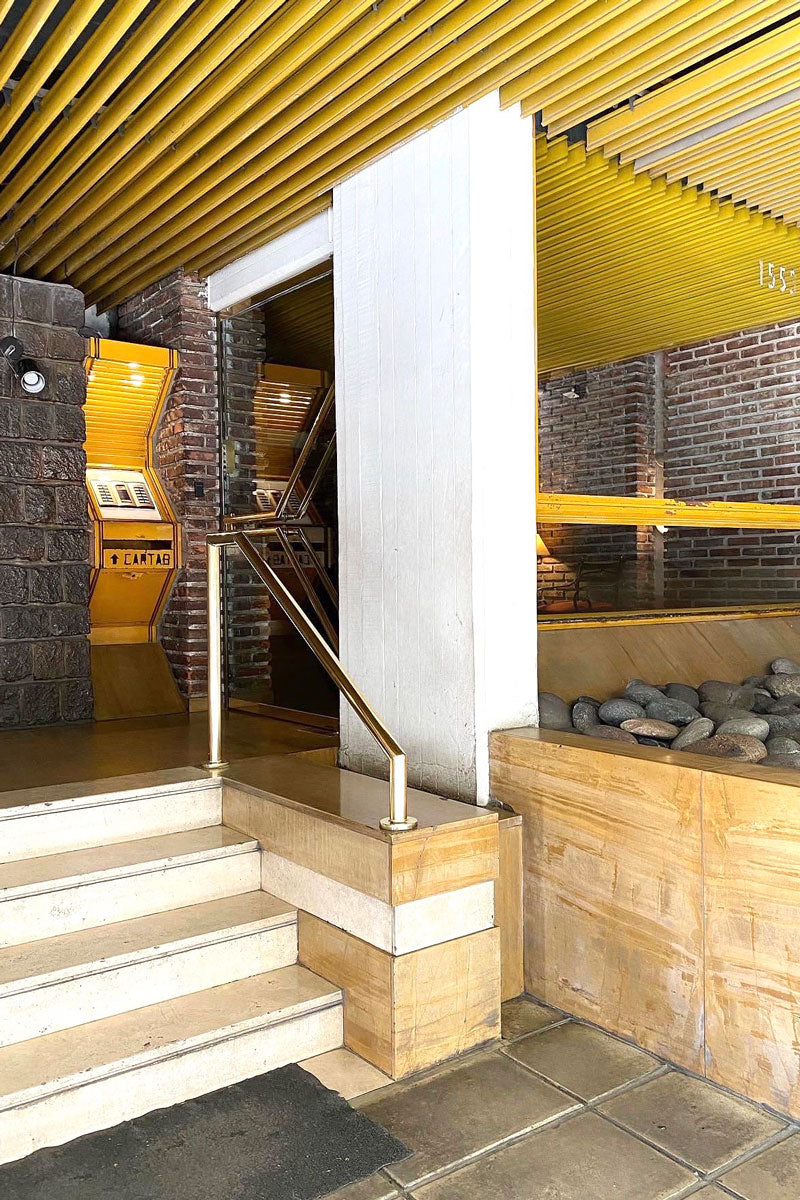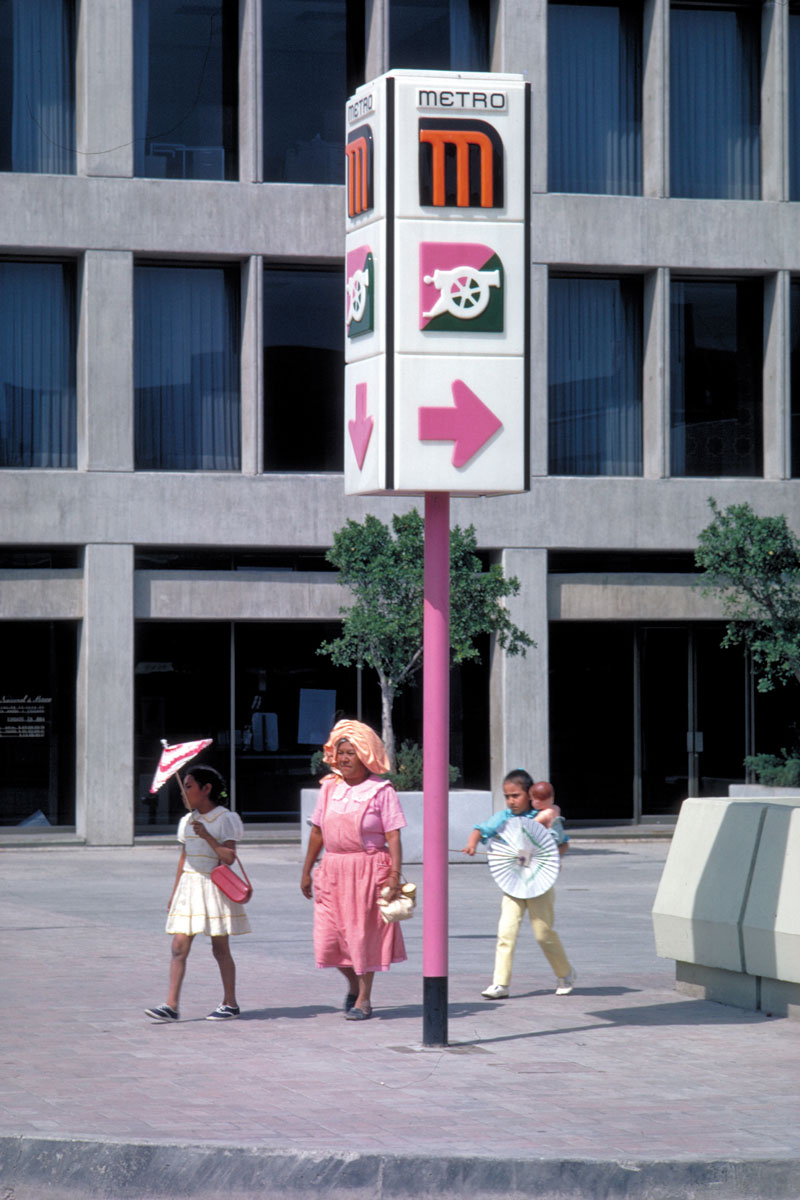Driving the Change Along the Adriatic

words by Melita Čavlović
The international promotion of post-WWII tourism in socialist Yugoslavia relied on numerous advertising strategies and various media formats. Featuring prominently among them were the humble tourist guides, many of them still available in second-hand bookshops or online auctions. Ranging from simple fold-out leaflets to more ambitious booklets, they were simultaneously travel aids and carefully scripted invitations for international tourists to brave a visit to an unknown, and at that point relatively undiscovered destination. They represented the coast through a series of symbolic representations of historic sights. These guides were disposable tools for motorized visitors that were more and more interested in discovering their own individual route along the coast.
Before the completion of the Highway, any attempt at organizing a visit to the Adriatic coast was very challenging and quite different in character. It relied mainly on coastal steamer routes and the relatively few ports they connected. The Highway permanently transformed the concept and character of traversing the coastal territory. The newly enabled access and rising automobile ownership led to a completely new way of reaching and perceiving traditional settlements, from their unfamiliar and often less than flattering inland sides. Initially serving primarily as a means of connecting individual historical cities, the Highway now allowed total access to the vast stretches of the coast between them. In some segments along its route, due to the spatial limitations of the coastal topography, the Highway still remains the only way of traveling along the coast. What follows here is a brief account of a period when the country began to open for international visitors, inviting them to discover the coast and choose their own preferred place in the shade along the 800 kilometer-long Eastern Adriatic coast.
The physical characteristics of this humble two-lane road, when put in the perspective of its far more ambitious European counterparts – the German Autobahn system and the, almost contemporary to the Highway, Italian Autostrada del Sole – could scarcely merit any serious international consideration, were it perceived only in terms of the scope of construction. However, the context of the initiation and completion of the Adriatic Highway, along with its subsequent importance in shaping the development of an entire country more than justifies its comparison with these two famous precedents, firmly establishing its interesting and unique position among these vastly larger projects. The instrumentality of the Autobahn network in the economic development of the country and its subsequent use in the political promotion of the state and its ideology is echoed in the importance of the Adriatic Highway as part of a wider state-building project in Yugoslavia, but with the crucial distinction of being on the opposite side of the political spectrum. The planned linking of the route with the already initiated construction of the central Brotherhood and Unity Highway was intended to spearhead the physical and ideological integration of the new country, creating a coherent spatial and political entity. Driving along these routes was thus expected to offer not only an opportunity of discovering the previously unknown natural features, but also to serve as a conduit for a better understanding of the many peoples of the new federal state.
The core work of designing the Highway and promoting its technical aspects to either professional or more broad audience was mostly not entrusted to architects, but to construction engineers. Nevertheless, modern architects were not indifferent to various consequences of laying the route of the highway into the hitherto untouched coastal landscape, and were de facto very much interested in initiating and elevating the discussion in available media. Supplementing the argument about contemporary concepts of tracing motorway routes in a 1947 issue of the journal Naše graðevinarstvo, the Croatian architect Antun Ulrich, clearly references the pre-war German literature borne out of the construction of the Autobahn network in his insistence on the significance of careful siting of routes in relation to topographical features. He pointed out the importance of vistas opening up in front of the driver as an active consumer of perspectives and panoramas effected by his physical movement through space. He thus emphasized the need to overcome the engineering dictum of economical linkages of adjoining points along the routes as efficient straight lines – a concept from the era of railroad construction – because for him “tracing and design [of routes] is not only an issue of resolving important technical problems but, in no small part, an issue of aesthetic considerations.” The publication of this text, that was extensively illustrated by selected examples of the completed Autobahn network, interestingly corresponds with the early activities around the formulation and advocacy of the idea of the Adriatic Highway. In sync with Ulrich’s reasoning, the laborious and meandering tracing of the Adriatic route was inherently suited to the idea of rhythmical exposition of varying vistas. This rhythmicity enabled not only the discovery but also an enhanced experience of the natural beauty of the coastal environment. These perceptual qualities of the Highway thus approach the aesthetic high standards initially championed by the 1930s Autobahn, the infamous German predecessor.
The comparisons with the Italian road construction miracle can also be instructive for understanding of the specific nature of the Adriatic Highway. Apart from the basic imperative of speed that guided the Autostrada project, it included a vast array of new typologies specifically developed along the route. Ranging from formally expressive pavilions to ambitiously engineered buildings bridging and connecting lanes in both directions, they orchestrated the spectacle of travel and helped organize the motorized journeys into distinct sections of the route. Each of those sections was traversed efficiently at high speeds without the need of stopping in between them. Reflecting the ambitious Italian example, the construction of the Adriatic Highway was followed by the extensive construction of a series of motels, viewing platforms, bistros, restaurants, or filling stations, albeit on a far modest scale. But the crucial difference, as clearly illustrated in the aforementioned travel brochures, apart from the far slower speeds that sometimes amounted to standstills during the peak days of summer, was the never-ending sequence of natural and cultural attractions that negated the need for additional architectural embellishments.
The political and social reality of Yugoslavia immediately after WWII was not conducive for undertaking projects as ambitious as the construction of the Adriatic Highway. While it coincided with the general imperative for renewal and upgrade of war-damaged infrastructural systems, the material and technical limitations on the ground prevented its southward expansion from progressing at the desired pace. The initial construction phases had to make do with minimal mechanical equipment, relying instead on collectivized manual labor, resulting in exceedingly slow progress along the proposed route. The impact of the international loan granted in 1963 was immediately reflected in the rapid progression of the construction, with the second half of the route finished and officially inaugurated in 1965. The sudden increase of vehicular visitors and the corresponding influx of foreign currency after the completion of the Highway secured the government’s interest in the potentials of the coast. Tourism was subsequently recognized as the key investment priority, given that it was becoming the main driver of the transformation of the entire Eastern Adriatic coast.
The construction of hotels along the coast had started even before the war, predating all attempts of integral spatial planning of the entire coast. But it assumed the characteristics of a mass industry, only after the completion of the Highway. However, all of these unpredicted outcomes of the construction of a road testify to its transformation from a modest local infrastructural project to a crucial vector of federal economic development. Being critically aware of the mass construction of hotel complexes elsewhere along the Mediterranean, the planners strived to prevent the excessive build-up of the coast. Assuming that the consumption of the coast would adhere to their recommendations, they relied on the concept of a rhythmic succession of dense new developments and stretches of unbuilt coastline between them. They assumed that this strategy of maintaining buffers of pristine nature between the planned zones of construction would ensure the long-term spatial boundaries to the tourist consumption of the Yugoslav coast. Simultaneously, they perceived the relative abundance of authentic nature as a crucial local specificity on the international tourist market. All that the visiting tourist had to do was to dynamically organize this succession of authentic pastoral scenes and modern tourist amenities into an active journeying experience, made possible by their car.
From the economical standpoint of advancing mass tourism, the Highway was quickly denounced as being too narrow and inadequate to support the desired growth. Opposed to that, the engineering standpoint continued to praise the construction aspect as innovative considering the meagre resources available to engineers. The earliest engineering attempts at tracing roads along this coast were stretches of Roman routes that were laid down as straight as “using a ruler.” They negotiated both the hills and the valleys, resulting in very steep segments. The initial planning projections of the route, due to the lack of adequate topographic maps and detailed surveying, plotted it only in principle. The prevailing economic and pragmatic interests advocated for the continuation of the straight-line principle, as it would result in considerable savings in construction expenses. Another strategy of cutting costs was based on the strict adherence to the remaining fragments of historical routes. Putting to use the sporadically existing segments of previous local dirty roads was a strategy of applying asphalt to existing gravel beds, reducing the manual labor of cutting new paths into the rocky landscape.
Due to the prolonged process of construction and the shift in political direction of the Yugoslav government, the initial projections which were done under the authority of construction engineers deviated considerably from the final result. The exact position of each segment of the route was determined by various interests vying for supremacy. This was aided by the fact that the initial proposals were determined without an adequate understanding of the actual terrain, as well as the specific characteristics of a mutable political system of self-management that empowered various local actors to become important political protagonists negotiating municipal and private interests directly on the ground. This resulted in the almost complete abandonment of the initial premise of circumventing smaller settlements, avoiding bottlenecks, or especially demanding natural obstacles, resulting in a meandering route that permanently inscribed on the ground many of these spatial conflicts.
The physical characteristics of the Adriatic Highway alone can scarcely warrant its inclusion among the main European motorways. Its average width of only seven meters, which is due to the steep and inhospitable terrain, was at times further reduced down to mere six meters. These physical limitations are equally reflected, especially in its northern segment, in discouraging small turning radii, resulting in the allowed speeds optimistically being set between 75 and 90 kph, even on the brief straight stretches that make them possible. When comparing it with the speeds that were being made possible along the Autostrada del Sol, it becomes apparent that this kind of motoring experience was well out of reach in the case of the Adriatic Highway. Instead, it had become a monument of a specific and brief period in the development of tourism when the experience of the journey was an end in itself. It was initiated at an early stage of the modernization of the country and very low domestic car ownership, relying in large part on foreign tourists as its primary users. The prototypical tourist at the time was expected to undertake a journey in his own car that would last for several days, often taking full six days to reach Dubrovnik as the final destination for the majority of visitors. These trips included the challenging northward return, necessitating the deployment of adequate service infrastructure. From the peculiarity of tuna fishing ladders, rocky beaches, lush terraced vineyards, impressive bridges or viaducts to careful placement of viewing platforms, the route was dotted with a wealth of visual stimuli. The journey was promoted as an impressive subjective experience of active discovery of precious sights along the coast.
The opportunity to push the promotion of natural beauties as an advantage of the Adriatic in advertising materials was up to a point the consequence of the delayed modernization of the state. The continuous lagging behind more developed western European countries in the number of foreign visitors and hotel beds was a strong motivation behind the incentive to raise tourist capacities. It is precisely the subsequent intensive construction of hotels, driven by the desire to accelerate the economic upswing of the country, that stood in conflict with the key asset of the aforementioned promotion – pristine natural beauty. They were not founded upon long and continuous sun-drenched and sand-filled stretches which were conspicuously monotonous for exploring with a private car but considered to be idiosyncratic to European Mediterranean countries, but on short swathes of gravel beaches, rocky inaccessible sections, and traditional settlements and towns. Meandering between these short scenes and sporadic attractions was backing the narrative presented in the brochures and ideally suited for independent tourist experience. And the backbone of this enterprise visually illustrated in maps of the coast and the protagonist of this essay was the automobile Highway which helped to stage this unique experience of the eastern Adriatic coast.
BIBLIOGRAPHY
Boltar, D., "Νeki aspekti planiranja i opreme Jadranske magistrale," Turizam, 11/4–5 (1963), 18–22.
Greco, L., Architetture Autostradali in Italia (Rome: Gangemi Editore, 2010).
Kečkemet, D., Jadranska magistrala. Rijeka Split Dubrovnik (Zagreb: Zajednica poduzeća za ceste SRH 1965).
Ulrich, A., "Trasiranje cesta za brzi promet," Naše građevinarstvo, 1/3–4 (1947), 130–145.
Vahrenkamp, R., The German Autobahn 1920–1945, (Lohmar-Köln: Eul Verlag 2010).
Zeller, T., "'The Landscape’s Crown': Landscape, Perceptions, and Modernizing Effects of the German Autobahn System, 1934 to 1941," in: Nye, D (ed.) Technologies of Landscape: From Reaping to Recycling (Boston: University of Massachusetts Press 1999), 218–238.


